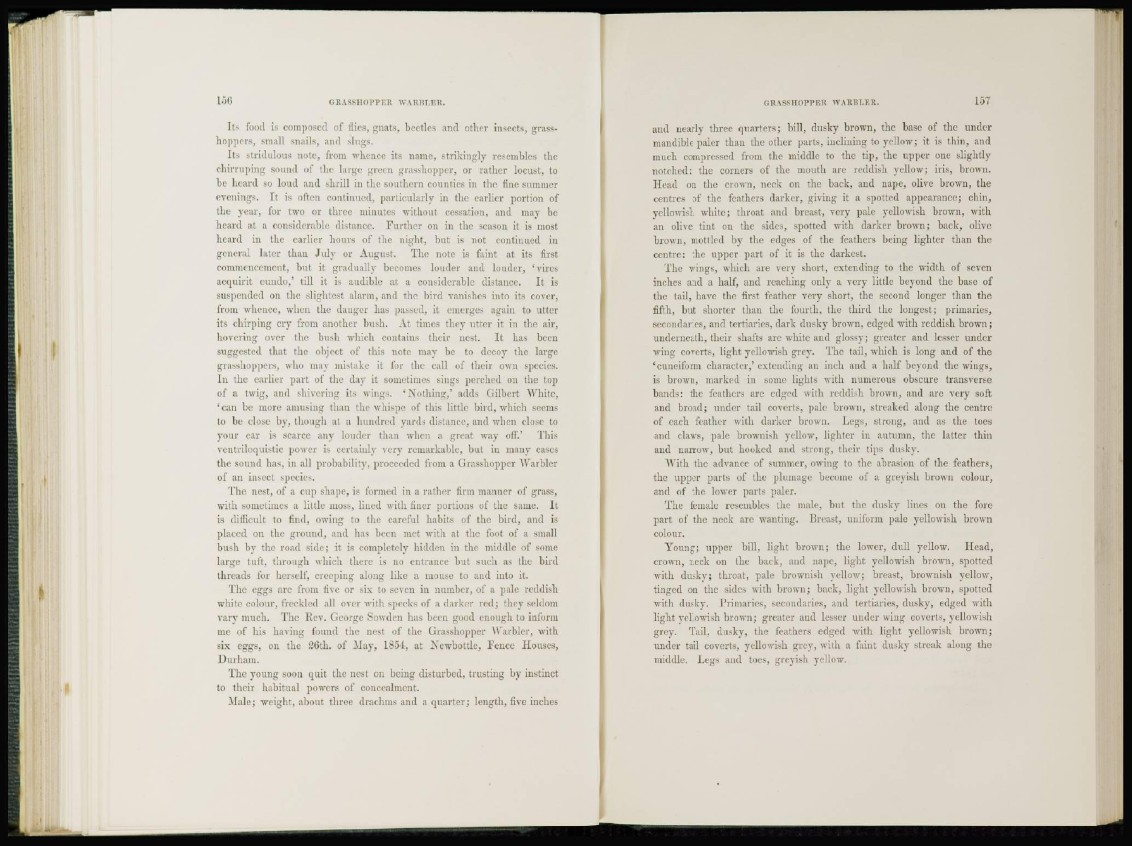
156 GRASSHOPPER WARBLER.
I n food is composed of flies, gnats, beetles and other insects, grasshoppers,
small snails, and slugs.
lis slridulous note, from whence its name, strikingly resembles the
chirruping sound of the large green grasshopper, or rather locust, to
be heard so loud and shrill in the southern counties in the fine summer
evenings. It is often continued, particularly in the earlier portion of
the year, for two or three minutes without cessation, and may be
heard af a considerable distance. Further on in the season if is most
heard in the earlier hours of the night, but is not continued in
genera1 , later than July or August. The note is faint at its first
commencement, but it gradually becomes louder and louder, 'vires
acquirit eundo,' till it is audible at a considerable distance. It is
suspended on the slightest alarm, and the bird vanishes into its cover,
from whence, when the danger lias passed, it emerges again to utter
its chirping cry from another bush. At times they utter it in the air,
hovering over the bush which contains their nest. It has been
suggested that the object of this note may be to decoy the large
grasshoppers, who may mistake it for the call of their own species.
I n the earlier part of the day it sometimes sings perched on the top
of a twig, and shivering its wings. 'Nothing,' adds Gilbert "White,
' c an be more amusing than the whispe of this little bird, which seems
to be close by, though at a hundred yards distance, and when close to
your ear is scarce any louder than when a great way off.' This
ventriloquistic power is certainly very remarkable, but in many cases
the sound has, in all probability, proceeded from a Grasshopper Warbler
of an insect species.
The nest, of a cup shape, is formed in a rather firm manner of grass,
with sometimes a little moss, lined with finer portions of the same. It
is difficult to find, owing to the careful habits of the bird, and is
placed on the ground, and has been met with at the foot of a small
bush by the road side; it is completely hidden in the middle of some
large tuft, through which there is no entrance but such as the bird
threads for herself, creeping along like a mouse to and into it.
The eggs arc from five or six to seven in number, of a pale reddish
white colour, freckled all over with specks of a darker red; they seldom
vary much. The Rev. George Sowden has been good enough to inform
me of his having found the nest of the Grasshopper Warbler, with
six eggs, on the 26th. of May, 1854, at Newbottle, Fence Houses,
Durham.
The young soon quit the nest on being disturbed, trusting by instinct
to their habitual powers of concealment.
Male; weight, about three drachms and a quarter; length, five inches
CrRASSHOPPER WARBLER. 157
and nearly three quarters; bill, dusky brown, the base of the under
mandible paler than the other parts, inclining to yellow; it is thin, and
much compressed from the middle to the tip, the upper one slightly
notched: the corners of the mouth arc reddish yellow; iris, brown.
Head on the crown, neck on the back, and nape, olive brown, the
centres of the feathers darker, giving it a spotted appearance; chin,
yellowish white; throat and breast, very pale yellowish brown, with
an olive tint on the sides, spotted with darker brown; back, olive
brown, mottled by the edges of the feathers being lighter than the
centre: the upper part of it is the darkest.
The wings, which are very short, extending to the width of seven
inches and a half, and reaching only a very little beyond the base of
the tail, have the first feather very short, the second longer than the
fifth, but shorter than the fourth, the third the longest; primaries,
secondaries, and tertiaries, dark dusky brown, edged with reddish brown;
underneath, their shafts are white and glossy; greater and lesser under
wing coverts, light yellowish grey. 'The tail, which is long and of the
'cuneiform character,' extending an inch and a half beyond the wings,
is brown, marked in some lights with numerous obscure transverse
bands: the feathers are edged with reddish brown, and arc very soft
and broad; under tail coverts, pale brown, streaked along the centre
of each feather with darker brown. Tegs, strong, and as the toes
and claws, pale brownish yellow, lighter in autumn, the latter thin
and narrow^, but hooked and strong, their tips dusky.
With the advance of summer, owing to the abrasion of the feathers,
the upper parts of the plumage become of a greyish brown colour,
and of the lower parts paler.
The female resembles the male, but the dusky lines on the fore
part of the neck are wanting. Breast, uniform, pale yellowish brown
colour.
Young; upper bill, light brown; the lower, dull yellow. Head,
crown, neck on the back, and nape, light yellowish brown, spotted
with dusky; throat, pale brownish yellow; breast, brownish yellow,
tinged on the sides with brown; back, light yellowish brown, spotted
with dusky-. Trimaries, secondaries, and tertiaries, dusky, edged with
light yellowish brown; greater and lesser under wing coverts, yellowish
grey. Tail, dusky, the feathers edged with light yellowish brown;
under tail coverts, yellowish grey, with a faint dusky streak along the
middle. Tegs and toes, greyish yellow.